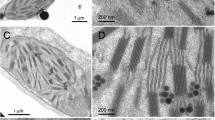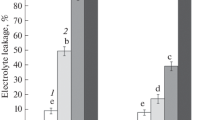Summary
Barley chloroplasts (Hordeum vulgare L.) have been isolated in aqueous medium by previously described techniques which preserve the outer plastid membrane in numerous chloroplasts. Thus “intact” chloroplasts are concentrated in “Class I” fraction and “non intact” in “Class II” fraction. A third type, “broken Class I”, is obtained by the action of a very dilute buffer solution.
The observation of freeze-etched preparations has shown that the main distinctive character between the two classes is not so much the presence or the absence of the outer plastid membrane, as it was assumed, as the state of the thylakoids. In Class I chloroplasts grana are shrunken, in those of Class II, grana are swollen. In both cases the outer membrane may or may not be preserved.
The breakage of chloroplasts resulting from treatment with osmotic shocks is due to the dilatation of the extra-lamellar matrix. The swelling of intra-thylakoidal volumes resulting from such a treatment is much less important.
It is shown that Class I chloroplasts have a very low NADP reductase activity which is strongly increased after the chloroplasts are broken by osmotic shocks. Such a treatment is without any effect on Class II chloroplasts, which always exhibit a low NADP reductase activity.
The situation is rather different in regard to photophosphorylation. It is also lower in Class II than in Class I, but after breakage by osmotic shocks the increase of this activity is weak, and much less significant than the increase observed in NADP reduction. The compression and cohesion of the thylakoids is not required for high photophosphorylation activity with artificial electron acceptors such as PMS. In this case cyclic photophosphorylation is higher in Class II than in Class I.
Similar content being viewed by others
Abbreviations
- ADP, ATP:
-
adénosine di et triphosphate
- EDTA:
-
éthylène diamine trétaacétate
- NAD, NADP, NADPH2 :
-
nicotinamide adénine dinucléotide, d° phosphate (formes oxydée et réduite)
- PMS:
-
phénazine méthosulfate
- Pi:
-
phosphate inorganique
Bibliographie
Arnon, D. I.: Micro-elements in culture solution experiments with higher plants. Amer. J. Bot. 25, 322–325 (1938).
—: Copper enzymes in isolated chloroplasts. Plant Physiol. 24, 1–15 (1949).
—, M. Losada, F. R. Whatley, H. Y. Tsujimoto, D. O. Hall, and A. A. Horton: Photosynthetic phosphorylation and molecular oxygen. Proc. nat. Acad. Sci. (Wash.) 47, 1314–1340 (1961).
—, F. R. Whatley, and M. B. Allen: Photosynthesis by isolated chloroplasts. VIII. Photosynthetic phosphorylation and the generation of assimilatory power. Biochim. biophys. Acta (Amst.) 32, 47–57 (1959).
Avron, M.: Photophosphorylation by swiss-chard chloroplasts. Biochim. biophys. Acta (Amst.) 40, 252–272 (1960).
Davenport, H. E., and R. Hill: A protein from leaves catalysing the reduction of heam-protein compounds by illuminated chloroplasts. Biochem. J. 74, 493–501 (1960).
Deamer, D. W., A. R. Crofts, and L. Packer: Mechanisms of light-induced structural changes in chloroplasts. I. Light-scattering increments and ultrastructural changes mediated by proton transport. Biochim. biophys. Acta (Amst.) 131, 81–96 (1967).
Dilley, R. A., R. B., Park, and D. Branton: Ultrastructural studies of the light-induced chloroplast shrinkage. Photochem. Photobiol. 6, 407–412 (1967).
—, and L. P. Vernon: Changes in light-absorption and light-scattering properties of spinach chloroplasts upon illumination: relationship to photophosphorylation. Biochemistry 3, 817–824 (1964).
Hongladarom, T., and S. I. Honda: Reversible swelling and contraction of isolated spinach chloroplasts. Plant Physiol. 41, 1686–1694 (1966).
Jensen, R. G., and J. A. Bassham: Photosynthesis by isolated chloroplasts. Proc. nat. Acad. Sci. (Wash.) 56, 1095–1101 (1966).
Kushida, H., M. Itoh, S. Izawa, and K. Shibata: Deformation of chloroplasts on illumination in intact spinach leaves. Biochim. biophys. Acta (Amst.) 79, 201–203 (1964).
Leech, R. M.: The isolation of structurally intact chloroplasts. Biochim. biophys. Acta (Amst.) 79, 637–639 (1964).
Lison, L.: Histochimie et Cytochimie animale, vol. II, 3° éd., p. 600. Paris: Gauthier-Villars 1960.
Lynn, W. S., and R. H. Brown: P/2e- ratios approaching 4 in isolated chloroplasts. J. biol. Chem. 242, 412–417 (1967).
Mathieu, Y.: Sur l'isolement, en milieu aqueux, de chloroplastes «intacts» à partir de feuilles de plantules d'Orge. Photosynthetica, sous presse (1967).
McCarty, R. E., and A. T. Jagendorf: Chloroplast damage due to enzymatic hydrolysis of endogenous lipids. Plant Physiol. 40, 725–735 (1965).
Mitchell, P.: Chemiosmotic coupling in oxidative and photosynthetic phosphorylation. Biol. Rev. 41, 445–502 (1966).
Moor, H.: Die Gefrier-Fixation lebender Zellen und ihre Anwendung in der Elektronenmikroskopie. Z. Zellforsch. 62, 546–580 (1964).
Moyse, A.: L'assimilation de CO2 par les préparations de chloroplastes isolés. Examen critique de ses facteurs limitants. In: Vol. dédié à la mémoire de N. M. Sissakian, Acad. Sci. URSS éd., 1968.
Nobel, P. S.: Relation of swelling and photophosphorylation to light-induced ion uptake by chloroplasts in vitro. Biochim. biophys. Acta (Amst.) 131, 127–140 (1967).
Packer, L.: Volume changes and contractility of mitochondrial and chloroplast membranes. Ann. N.Y. Acad. Sci. 137, 624–640 (1966).
—, A. C. Barnard, and D. W. Deamer: Ultrastructural and photometric evidence for light-induced changes in chloroplast structure in vivo. Plant Physiol. 42, 283–293 (1967).
Shavit, N., and M. Avron: The relation of electron transport and photophosphorylation to conformational changes in chloroplasts. Biochim. biophys. Acta (Amst.) 131, 516–525 (1967).
Spencer, D., and H. Unt: Biochemical and structural correlations in isolated spinach chloroplasts under isotonic and hypotonic conditions. Aust. J. biol. Sci. 18, 197–210 (1965).
Walker, D. A.: Correlation between photosynthetic activity and membrane integrity in isolated pea chloroplasts. Plant Physiol. 40, 1157–1161 (1965).
Author information
Authors and Affiliations
Rights and permissions
About this article
Cite this article
Bourdu, R., Mathieu, Y., Miginiac-Maslow, M. et al. Structure granaire, réduction du NADP et photophosphorylation des chloroplastes isolés de feuilles d'orge. Planta 80, 191–210 (1968). https://doi.org/10.1007/BF00385595
Received:
Issue Date:
DOI: https://doi.org/10.1007/BF00385595




